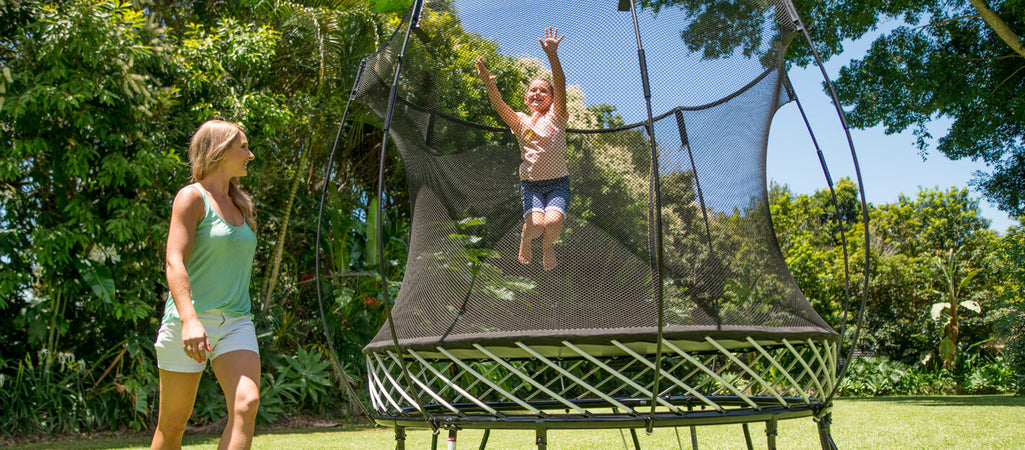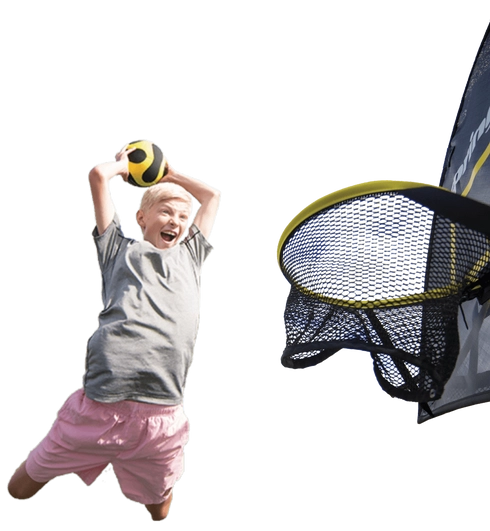The History of the Trampoline
min read

Trampolines have come a long way since their invention in the 1930's. With the introduction of Springfree® Trampoline in 2013, the trampoline was redefined, with safe options now available.
We take a look back in time at the history of trampolines, right from the idea that came to the mind of trampoline inventor George Nissen in the 1930's...
The Invention
George Nissen’s obituary, published by The Independent, a UK online news publication, tells the story of his invention of the trampoline, and the history of it, in great detail;
George Nissen, at the age of 16 in 1930, was amazed to see trapeze artists bouncing into the safety net below. Nissen was a keen gymnast himself, and seeing a travelling circus in Iowa, he thought it would be even more amazing if the trapeze artists could continue bouncing off the net and do more tricks.This led Nissen to create something he called a bouncing rig, in his parent’s garage. The bouncing rig was a canvass sheet strapped to a rectangular steel frame.
In 1934, Nissen, with the help of his Gymnastics coach at the University of Iowa, added more bounce by connecting the canvas to the frame with the inner tubes from tyres. These inner tubes were later replaced by coil springs.
Nissen started performing on his creation, and performed in Mexico, where he discovered that the Spanish word for diving board was ‘el trampolín.’ He added an e, and registered “Trampoline” as a trademark for his invention. In 1942, the Griswold-Nissen Trampoline & Tumbling Company was formed, and started making trampolines commercially.
There was some bad publicity, from cases of people getting injured on trampolines, which affected their popularity in the early stages. Eventually, after much publicity and touring, trampolines took off, and Nissen faced competition from other trampoline companies.
(Source: The Independent, UK, Obituary: George Nissen, Inventor of the Trampoline. Published 5.5.2010 by Anthony Hayward. http://www.independent.co.uk/news/obituaries/george-nissen-inventor-of-t...)
Early Uses
Initially, the trampoline was used as a training tool, not for recreational use.
American and Soviet astronauts started using trampolines for their training, to improve their physical fitness and to prepare themselves for the feelings of weightlessness. Athletes from other sports also used trampolines as a training tool. Trampolines were used to develop and perfect acrobatic skills for diving, gymnastics, and skiing.
Eventually, people started jumping on a trampoline just for the fun of it, and it became popular as a recreational activity.
The Evolution of Safety
Traditional trampolines struggled from a high number of injuries and law suits from lack of training and supervision, they were removed from schools, except specialist gyms, with certified trainers.
Trampoline foam pads were introduced, to help protect the jumper against the strings, but a high number of injuries still occurred on spring-based trampolines, with the pads becoming flimsy, not providing much protection, and with injuries occurring when jumpers came into contact with the edge of the trampoline.
Nets were added to try to keep the jumper in the trampoline, but the majority of trampoline nets had hard poles, causing hard surfaces for the jumper to come into contact with.
This spurred Springfree® Trampoline inventor, Dr Keith Alexander, to create the World’s Safest Trampoline™. The Springfree Trampoline design eliminates the impact areas responsible for 90 percent of all product-related trampoline injuries.
The Introduction of Springfree Trampoline
Springfree® Trampoline was introduced in 2003, and available in Australia in 2004.
Dr Keith Alexander, Dad and Engineer, re-designed the trampoline from the ground up to invent Springfree Trampoline, over fifteen years of research and development.
Dr Alexander wanted his daughter to have a trampoline when she was 2 years old, but was worried trampolines were too dangerous. He found that in the US during this time, there were 100,000 children a year injured on trampolines, mostly from falling on the frame or springs, or falling off altogether. As an inventor, he decided to do something about it, and started his mission to redefine the trampoline, and provide safe backyard play for kids.
Dr. Keith Alexander reengineered its design to eliminate the impact points that are the cause of most trampoline injuries. His dedication and our belief that children deserve safe backyard play fuels our commitment to education and our passion for innovation and quality. Today, more than 20 years after the Springfree journey began, our mission remains the same. It is, quite simply, to change the definition of trampoline.
Our springless patented design has not only changed the way trampolines work but eliminated the impact areas that cause 90% of all product-related trampolines injuries.
You can now purchase a Springfree Trampoline in over 15 countries, with offices and stores in Australia, Canada, New Zealand and USA.
Trampolines have come a long way from the original invention in the 1930’s. And they’re now a lot safer.
Providing excellent health benefits, enjoyment for all ages, and an excellent work-out for adults, the Smart Trampoline ™ gets the whole family outside and active, in a safe way.

